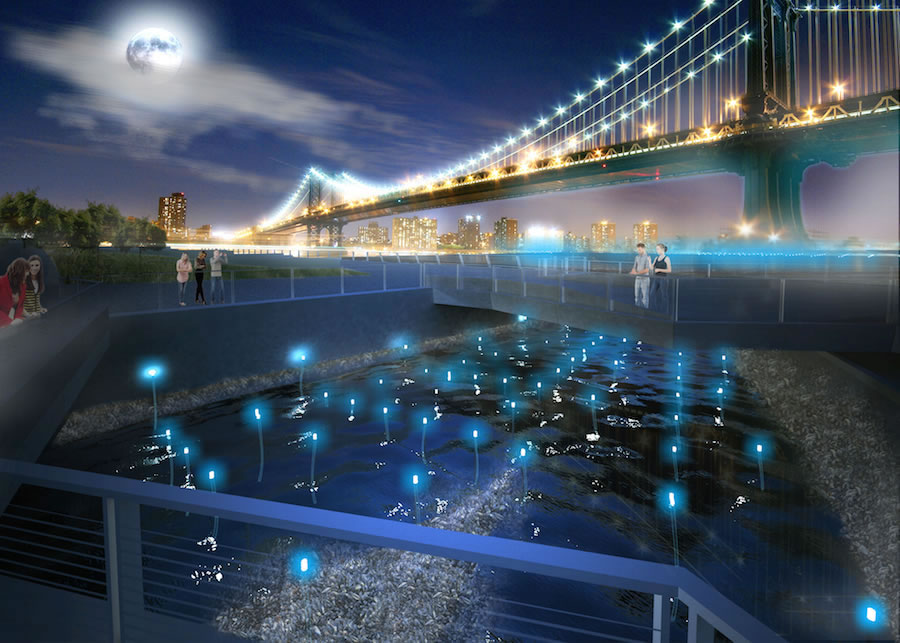In 2004, an interdepartmental study concerning Lower Manhattan’s two-mile East River Water- front Esplanade was conducted—a byproduct of then-mayor Michael Bloomberg’s “Vision for a 21st Century Lower Manhattan.” The white paper outlined a set of value-based target objectives aimed at strengthening the cultural, architectural, and environmental attributes of the southernmost pocket of New York’s loftiest borough. Among the multitudinous projects that followed the yearlong undertaking was, accompanied by SHoP Architects, the New York City Economic Development Corporation’s (NYCEDC) revitalization of the East River Waterfront Esplanade and its neighboring Pier 35.
Meanwhile, futurist David Benjamin of The Living New York firm, in collaboration with artist Natalie Jeremijenko, were busy generating buzz with a recently completed prototype of a collaborative project they dubbed Amphibious Architecture wherein buoys, laden with sensors and plotted along the Bronx and East rivers, triggered LED signals in response to various elements of aquatic activity. Imposing a central theme of interconnectivity on human life and its presiding natural environment, and further monitoring the relationship between them, the duo naturally attracted the eager attention of the NYCEDC. By 2012, the two parties were bound by contract and the Pier 35 EcoPark project went into development, with Amphibious Architecture serving as the template to work from.

Tracking the Trajectory: Pier 35 EcoPark
2004
An interdepartmental study was conducted (a byproduct of Bloomberg’s “Vision for a 21st Century Lower Manhattan”) about the East River Waterfront Esplanade, outlining objectives aimed at strengthening the cultural, architectural, and environmental attributes of the area.
2012
David Benjamin’s The Living joins forces, via a contract, with the New York City Economic Development Corporation (NYCEDC) to put Pier 35 EcoPark into development, basing the design off of The Living’s prototype project, Amphibious Architecture.
2017
Although the Pier 35 EcoPark has seen delays, some of which are a result of Hurricane Sandy’s effects, construction is slated to resume in the fall. The NYCEDC predicts the project will be complete by 2017.
Parlaying the integrated approach of his previous venture into the redevelopment of the pier, Benjamin expounds, “we are very interested in the intersection of biology, computation, and design.” Over the course of Benjamin’s career, this area of interest has evolved into a central tenet of his profession, and one that has likewise enforced itself as the very framework of the renewed Pier 35. Such interactivity is effectively demonstrated by the technical communication of environmental health within the project, for example, a “shadow pier” comprised of floating tubes arranged in the East River parallel to the esplanade. The tubes, like the “Amphibious” buoys, employ sensors that monitor water quality and presence of underwater species. The detections are then relayed via two layers of color-coded LED lighting cues. If the water is cleaner than the previous week, the upper layer transmits a bluer color, while a “warmer” tone indicates a downgrade, while the lower LED layer traces the trail of fish activity. Meanwhile, identical tubes hang below FDR Drive measuring air quality in a like fashion.
Unifying human beings to their surrounding ecosystem in a revolutionarily literal sense, as guests may text message the floating shadow pier tubes and, in reply, receive neat, real-time facts and information based on what the tube sensors are presently gathering. The intention is to create a platform that can facilitate and simplify dialogue concerning the precarious standing of environmental quality. “The idea that citizens can ‘text the river’ is meant to make people pause and wonder about their technology, their environment, and their world. One feature I love is that as soon as someone texts the river, this inanimate object becomes a contact in their phone.”
The addition of a live mussel habitat especially demonstrates Benjamin’s cross-disciplinary principle by merging “artificial intelligence and natural intelligence,” in effect engendering a receptive biomechatronic cyborg entity, not unbefitting for the theme of the installation. To breathe, mussels must open their shell, and the degree of the gape responds directly to the quality of water they inhabit. As is the case with the FDR Drive and shadow pier tubes, the results are collected with harnessed biosensors. “This is an example of harnessing natural intelligence and making it part of the palette of design,” explains Benjamin, emphasizing an urgency for “developing new hybrid possibilities that combine artificial and natural, digital and biological, new and ancient technologies.”

A prototype of this system was commissioned by the U.S. Pavilion for the Venice Biennale in 2012.

Instead of seeing the river’s surface as a mirror to reflect our own skyline and our own image, a two-way interface between the interrelated systems of land and water is established.

